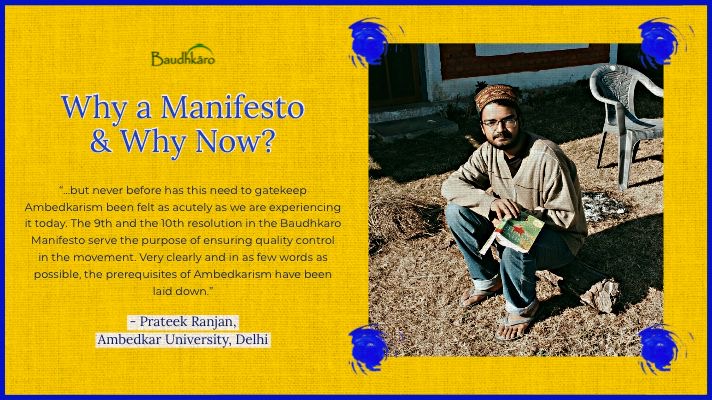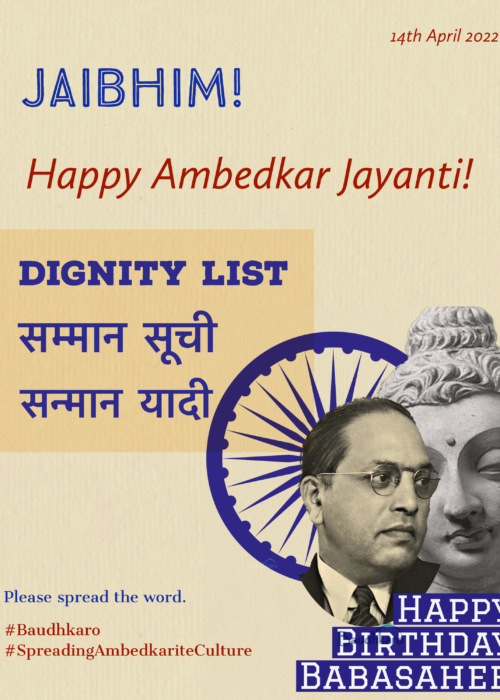Prateek Ranjan writes his thoughts on the Baudhkāro Manifesto
Formerly this mind wandered about as it liked,
XXIII. Nagavagga (Pāḷi 326 [23.7] Nāga)
where it wished and according to its pleasure.
But now I shall thoroughly master it with
wisdom as a mahout masters with his ankus
an elephant in rut.
“Our spirit suffers from needs other than those inherent in life. We are suffering from corruption, from the corruption of reason…Come. Save us from these worms. Invent new houses for us.”
Antonin Artaud, “Letter to the School of Buddha” (1925)
(1)
Manifesto – because of a need to bring clarity to a world engulfed in flames of confusion.
Never before has there been a campaign of (mis)information of catastrophic proportions as the one which we face today. We suddenly find ourselves overburdened with an arsenal of concepts, ideas, values, dictates, principles, theories and slogans flowing seamlessly in real time from all over the globe right into our hands. With an incredibly short attention span, our generation finds itself constantly flirting with multiple historical discourses and ideologies with little or no depth in its actual involvement and thereby reducing the entire exercise of mental training and consciousness formation into a highly superficial, muddied, convoluted, and myopic transaction.
The young in every generation find themselves easily seduced by the attractions of revolution. The clarion calls of Freedom and Swaraj have played out extensively in the history of the Indian Subcontinent as well. These were accompanied by rapid production as well as consumption of “Revolutionary Literature”. Just like literature on the French Revolution inspired Karl Marx of the subsequent generation, Marx’s writings became the fount of revolutionary literature for the children of modernism. Marx gave to modernity its first revolutionary manifesto- The Communist Manifesto. Marx’s manifesto continues to enthral millions of hearts and hormones especially in India where a strong lobby of Communists can be found operating since the pre-Independence days.
The unique nature of India is such that we have diversity even in our options for revolutionary manifestos! Just like the communist lobbies, religious revolutionaries also found an over enthusiastic audience in the subcontinent. To top all these different and contesting ideologies of revolution, the Indian National Congress under the ideological umbrella of Gandh-ism and later Nehru-ism outran all of them but not before co-opting elements of every other contending revolutionary ideology of its time. By presenting itself as the grandiose and spectacular manifestation of Freedom or Swaraj, INC became the self-anointed Amir cum Imam of Hindustan. Like a child in a toy shop, the young minds of a highly volatile but politically independent India, found they were facing a stockpile of contesting revolutionary manifestos all constantly vying to own their allegiance. What was common in all of them was an extreme rejection of the status quo. However what all the aforementioned manifestos completely missed was creation of something new and beautiful. Their entire revolutionary zeal was monochromatically directed towards destruction of the ‘other’ and very soon it became evident that revolutions could never bring social transformation but only induce a transfer of powers at the level of governance. A revolution can usher in new laws, new codes of conduct, a new flag, a new territorial boundary, a new Wazir. And yet Revolution in all its glorious history failed to affect an iota of change in the character of man.
A world in which everyone is talking about ‘Freedom’, ‘Revolution’ and ‘Independence’; is it not pertinent for us to ask what do these words actually mean?
‘Freedom for who and Freedom from whom?’
This was the question which Dr. Ambedkar asked the Congress leader M.K. Gandhi as well as the Radical Leftists led by Laski, Kingsley, Martin, Brailsford, Lois Fisher and others. He considered the youth carelessly flirting with foreign flavours of revolution as a serious problem for the future of democracy. Intellectually immature, hyper-masculine and overtly-passionate notions of revolution has led many a campaign of death and destruction in human history. The octopus reach of misinformation by the time the world hit modernity became so vast that it would have required nothing shy of a Herculean effort to challenge the counterrevolutionary manifestos circulating and impressing young minds all over the world. At this point Dr. Ambedkar accepted the challenge and on 14th October 1956 set a precedent for a revolution so sublime that the flow of History actually witnessed a rupture! It is easily arguable that Dr. Ambedkar’s entire life was a historical rupture in every sense of the term. His contributions during the 1940s in the formation of the Indian Constitution had changed the course and destiny of billions towards a secure future. However he was not satisfied by the Political safeguards he had managed to secure after decades of missionary toil in the constitutional offices. He could not let the counter revolutionaries escape with their dystopic and anarchic models of revolution left uncontested. Despite failing health and after years of selfless service to humanity, Dr. Ambedkar continued to persist firmly in his sacred mission of actualizing an egalitarian Revolution which culminated finally in Nagpur with the famous declaration
“Today I am having a re-birth.’
In a poignant and emotional anecdote, the head of the Western Buddhist Order, Bhikku Sangharakshita, described his final encounter with Dr. Ambedkar shortly before the latter’s Mahaparinibbana. He described Dr. Ambedkar as very ill and unable to speak clearly- a shocking change from his usual booming voice. Dr. Ambedkar was repeating something continuously in an impassioned manner, but inaudibly, to Sangharakshita. He placed his ears close to Dr. Ambedkar’s lips to be able to hear what he was saying. Dr. Ambedkar’s last words to the Bhikku to whom he had entrusted the Buddhist education of the millions of new converts were
‘There is still so much to be done…So much to be done.’
So what is Dr. Ambedkar’s Revolution? Revolution he explained is not a temporal process determined by historical conditions. Indeed man is free only when he is no longer determined by historical, social, or any such so called objective conditions. Revolution takes place within the human consciousness. Hence the creation of even the most conducive historical conditions cannot be regarded as a revolution, not even temporarily. Whenever the reason for and ultimate justification of a revolution is sought in socio-historical processes, the revolution will sooner or later find itself defending some status quo as its own end and justification. Socio-political revolutions are inadequate for the attainment of freedom and enlightenment. The ultimate source of Dr. Ambedkar’s Buddhistic revolution lies beyond the constraints of social and historical contexts. It neither begins nor ends in the realization of any form of political order. His is a philosophy of perpetual revolution.
(2)
Just like a seed requires constant care and attention in order to grow into a tree and provide shade from the scorching sun, ideas also require continuous propagation in order for them to make an impact. Once a man asked Gabriel Appadurai the eminent intellectual successor of Pandit Iyothee Thass and leader of the Tamil Buddhist Rennaisance; whether he believed in the possibility of rebirth. Gabriel Appadurai answered that repeating the words spoken by Lord Buddha after a temporal vacuum of more than two thousand years is itself an irrefutable proof of Re-Birth. This brings us finally to The Baudhkaro Manifesto. Why was a need felt to write a new Manifesto suddenly? The answer is simply to counteract the colossal campaign of disinformation and distortions which reared its ugly head immediately after 1956.
The primary functions of any Manifesto are to bring clarity into confusion, make conspicuous and apparent the objectives, aspirations and methodology of the movement. The massive tomes of Dr. Babasaheb Ambedkar’s writings and speeches running into seventeen extensive volumes have been weaponized by every contending political and extra-political outfit to suit their personal motives. By projecting Dr. Ambedkar as a newfound demigod, a larger than life and highly dramatized and even caricaturized persona, these political lobbies with vested interests quote his selective words in a highly de-contextualized fashion almost as if they were written in stone and in complete isolation from rest of his writings. This manifesto helps us put into logical order and progression the process through which the Ambedkarite revolution happens.
Under such critical conditions where thousands of young people are being peddled counter-revolutionary definitions of freedom in the name of Ambedkarism, The Baudhkaro Manifesto is a timely and much awaited intervention. It comes like the freshness of an oasis after wandering in a desert for all life. This Manifesto is a projection, a rebirth of Ambedkarism in our contemporary world. It is an open challenge to all those bootleggers of counterfeit revolution who are fanatically recruiting foot soldiers in preparation of a war which they have promised to fight one day in distant future. This Manifesto is an appeal to all such misguided radicals to snap out of their perpetual paranoia of an oncoming war and instead divert their precious energies towards cultivation of their mind and securing actual positive transformations for the society. This Manifesto might appear to some as assuming the exclusive gatekeepership of Dr. Ambedkar’s legacy and even trigger angry emotions in few. But never before has this need to gatekeep Ambedkarism been felt as acutely as we are experiencing it today. The 9th and the 10th resolution in the Baudhkaro Manifesto serve the purpose of ensuring quality control in the movement. Very clearly and in as few words as possible, the prerequisites of Ambedkarism have been laid down.
“There cannot be Ambedkarism without Buddhism and hence,
one cannot be an Ambedkarite without being a Buddhist.”

Very few individuals and collectives have realized the intensity and the significance of Dr. Ambedkar’s final wishes. A lot many have actually realized his exact idea of revolution but feeling professionally/ ideologically threatened have worked systemically in organized lobbies to counteract the Ambedkarite Revolution through a sustained campaign of distortions and misinformation. The success of factional lobbies working systemically to misuse Ambedkarism in furthering their ‘Anti-‘ isms has been understood as a direct consequence of an absent Sangha-centralized and socially pervasive. The 22nd resolution of the Baudhkaro Manifesto defines their area of focus as strengthening the Sangha. This Manifesto is a step towards its realization. Dr. Ambedkar’s vision of a strong and dedicated Sangha working with missionary zeal to remove suffering from the society received scant attention by his self-appointed ideological successors. They found no bone in completely ignoring the last wishes of the man upon whose remains they instead chose to run petty shops and peddle fake prophecies of the beginning and the end of this world. The Baudhkaro Manifesto grabs the attention of the world and jerks it rather forcefully towards the most sacred duty which it had been consciously neglecting- that of making constructive contributions towards a more compassionate and egalitarian world. It forces the readers to look closely at the moral degeneracy with which it has been chasing the chimera of social justice. This manifesto rescues the spirit of revolution from the confines of performative political adventurism and instead challenges every radical to risk a much less travelled, lonelier and extremely dangerous path of achieving socio-cultural transformation in society. This Manifesto is a telling example of choosing the means over the ends insofar as the means itself eventually become the end. The journey becomes the destination.
The law of Sociology states that the amount of political consolidation of any social group is inversely proportional to its socio-cultural progress. By always remaining in a competitive mode, the society looking to consolidate its political identity must necessarily neglect its focus on progressive integrative reforms and rather regress into its medieval, fundamentalist and puritanical versions. The Baudhkaro Manifesto is looking at the future. It is not so much worried about the past. The historical injustices and antipathies of past can be corrected only by the creation of something beautiful, progressive and beneficial for the world. An obsession with a toxic past kills any scope of positive creativity in the present. This doesn’t mean that we should look away from history but rather we understand history dispassionately and objectively and we choose with utmost care all that is beneficial from our past to use in our revolutionary project of reconstructing the world.
Baudhkaro inhabits that unique footrest in the spectrum of contemporary intelligentsia, art and activism where we can clearly see Dr. Ambedkar’s very crucial Blueprint of Buddhism actually being put to test. Commonly theology remained confined as an exercise in spiritual ideation divorced completely from material realities unless a threat to security emerged. The Baudhkaro Manifesto pushes forward this ideational attitude into field of direct action. The repeatedly iterated urgency of taking forward Dr. Ambedkar’s revolution makes a deep impact and successfully induces a strong fervour for discipline, clarity, organization and uncompromising fidelity in the entire Buddhist movement. This manifesto stands out in stark contrast from the large mushrooming body of current counter-revolutionary literature. While the rest contend themselves by merely by parroting the name of Dr. Ambedkar as a professional or political formality, the Baudhkaros have chosen to live and practice Ambedkarism as a way of life.
Instead of weaponizing Ambedkarism to channelize inner hatred and jealousy and achieve sectarian goals, the Baudhkaros have planted its seeds all around them which by the logic of nature must one day sprout into beautiful Bodhi trees and provide fruits and shade to all- man and beast alike. Their unwavering contribution towards realizing Babasaheb’s vision of Prabuddh Bharat is immeasurable, invaluable. Their solution oriented approach coupled with the missionary zeal of dedicated upasakas sets a lofty standard for all who try and claim the banner of Ambedkarism for themselves. Unless the demands made by the Baudhkaro Manifesto are either met or logically refuted and disproved, it shall continue to remain the exclusive Gatekeeper of Babasaheb’s glorious legacy.
Bhagwan Buddha was sure of the foundations of his Dhamma. He knew that the subterranean roots of the Dhamma had dug so deep in the sub-continental soil that no Iconoclastic violence could ever uproot it completely. As the seasonal monsoon arrives, new flowers shall blossom. They blossomed in 1956 and despite every odd shall continue blossoming as long as we have Samta Sainiks such as the Baudhkaros spreading the seeds of the beautiful Buddha Dhamma all over the world. In conclusion, I would like to thank team Baudhkaro from the bottom of my heart for finally making this much needed intervention in the Buddhist movement.
– Prateek Ranjan
Prateek is a student of English Literature, Comparative Religion & Performance Arts. He received a project fellowship from the Department of Curriculum Studies, NCERT, in 2020. He has authored several essays on English Poetry, Post-Colonial studies and Indian writings in English for journals published by Jamia Millia Islamia, Tripura University, Bangaluru University etc. Prateek lives in New Delhi and is currently writing a book on the history of Buddhist Renaissance in India.




